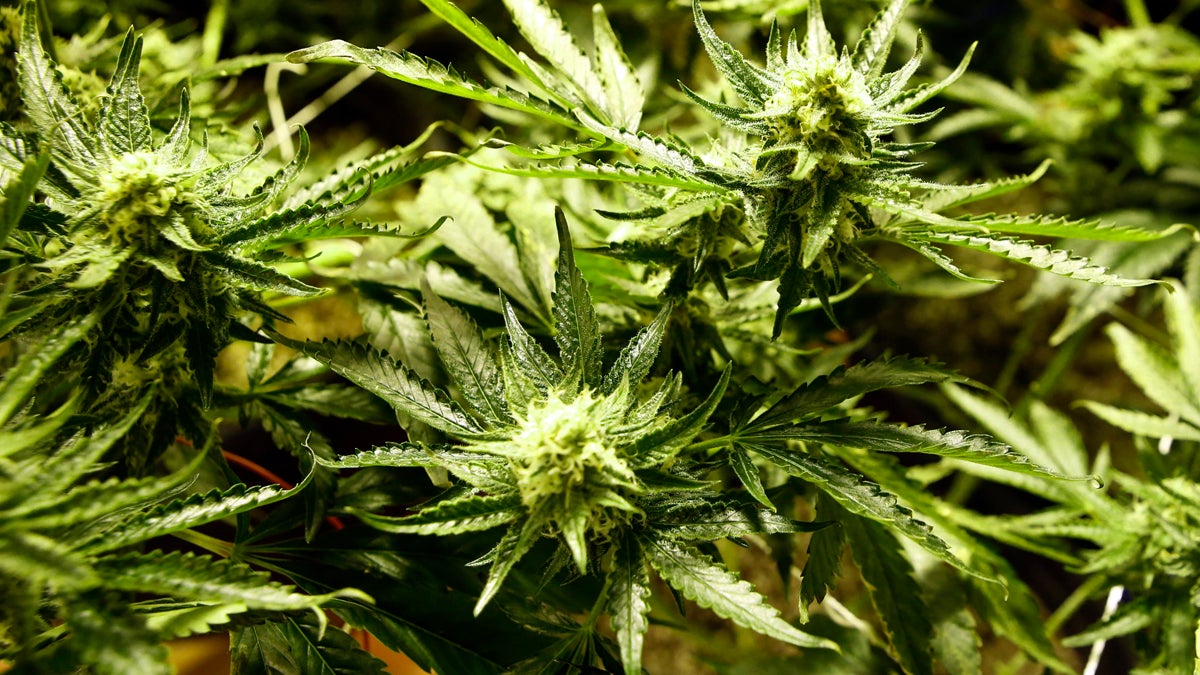Medical questions linger as marijuana legalization proposal hits New Jersey
Listen
(AP Photo/Ed Andrieski
What do we know about marijuana’s impact on our brains?
At the start of the New Year, as a new law went into effect legalizing the sale of pot for recreational use in Colorado, pictures of people buying marijuana in “smoke shops” across the Centennial state were splashed across the media. Washington state will soon follow suit and lawmakers in the Delaware Valley are watching with interest.
Colorado stands to reap millions of dollars in tax revenue from the sale of pot, and this has caught the attention of New Jersey state Senator Nicholas Scutari. He’s introduced a bill to legalize marijuana for recreational use. In a recent interview, Scutari said, “We’re talking in New Jersey—just sales and tax revenues—of hundreds of millions of dollars for New Jersey. That’s not to mention the secondary effects of having fuller employment, of having people in sales and farming jobs and contracting jobs that would go along with it.”
Discussions about legalizing marijuana are usually highly charged—morally, medically, and even politically. But what do we really know about the long-term effects of using marijuana? Marijuana for recreational use is illegal on the federal level, so research has been slim compared to that involving alcohol. But in looking at the studies that have been done, it’s clear that marijuana use can be detrimental to teens and young adults, in particular.
Impact on teens and young adults
Dr. Krista Lisdahl is assistant professor of neuropsychology at the University of Wisconsin-Milkwaukee, and lead author of a review of studies done over the last decade on marijuana and its effect on the brain. When asked about legalization for recreational purposes, Lisdahl pointed out that during the teenage years and into the early 20s, the brain is still developing.
“There’s this pruning of the gray matter, which includes the neurons, where inefficient connections are being eliminated and the brain is getting more specialized. At the same time, we see an increase in white matter, and that’s the fatty lining of the axons of the neurons, and basically with those two things together, we see that the adolescent and emerging adult brain becomes more adult like, becomes more specialized, becomes more efficient.”
“Using marijuana regularly during this period,” Lisdahl goes on, “this means a couple times a week all the way up to daily, may actually disrupt this development. So we see alterations in gray matter, those neurons. And we also see reduced white matter integrity.”
This is bad news, according to Tom McLellan, head of the Treatment Research Institute in Philadelphia. “It affects motivation, cognition, ability to inhibit, and the ability to concentrate; functions that are really useful in school, work, and other areas,” he warns.
Even though marijuana would not legally be sold to anyone under 21, researchers say most people start to experiment in their teens. McLellan said if an adult buys it, younger people will find it.
“My best examples to corroborate that would be alcohol. That’s where kids get a lot of the alcohol that they use, and most recently, prescription opioids,” McLellan says.
‘It’s not trivial’
Scientists say marijuana can be addictive, and that long-term use can lead to intellectual damage. Dr. Lisdahl pointed to a general health study conducted in New Zealand over an 18 year period, which also examined frequent marijuana use.
“If [they] started regularly before 18, when they were 38, they had an eight point IQ loss,” Lisdahl says. McLellan concurred, “That’s the thing that keeps you out of college, that’s the kind of thing that will keep you from getting a pilot’s license. It’s not trivial.”
So if you are a regular user and you decide to stop, can the brain recover? According to Dr. Lisdahl, researchers are trying to determine whether sustained abstinence can improve brain function to baseline levels. However, progress can take awhile.
“Even after 30 days of abstinence, adolescent and young adult marijuana users have a hard time sustaining their attention over time, take more time on complex cognitive tasks, and overall they have trouble learning new material,” says Lisdahl.
Increased THC levels
Marijuana contains tetrahydrocannabinol, which attaches to receptors in the brain, helping to produce the feelings of relaxation and even euphoria users seek. Today’s pot is a lot more potent than it was “back in the day.” According to Lisdahl, the THC content is 15-20 percent, as opposed to four percent 20 years ago.
“Makers have actually genetically engineered the plant to have higher THC contents, so users smoking the pot experience a bigger high, and more euphoria. The problem is, it also comes with greater side effects, like anxiety, panic and paranoia.”
Tom McLellan is concerned this much stronger version will be heavily marketed toward teenagers. Doctor Lisdahl said that’s something that’s already happening in Colorado.
“Marijuana pops, marijuana brownies. If you look at the packaging, they’re clearly not marketing these to 40 year olds. This is very youthful marketing.”
What about drugged driving?
So is marijuana use safe for anyone? There is some agreement in the scientific world that adults who are over 25, and do not suffer mental health issues, can probably indulge occasionally and not see long-term changes in the brain. However, one big public safety issue that affects everyone is drugged driving.
According to Tom McLellan, there has already been a significant elevation in the number of marijuana-related driving incidents in Colorado. Senator Scutari pointed out that there are laws on the books against drugged driving in New Jersey, but researchers have yet to pin down exactly how long a user should “sit it out” after getting high. Dr. Lisdahl has looked at studies of people who have used medical marijuana to help with multiple sclerosis, and found some lasting impairment.
“They showed impaired driving for two to five hours after their dose, and really, they weren’t safe until 24 hours later,” says Lisdahl.
As far as legalizing is concerned, McLellan wants Jersey to wait.
“I would say to the state of New Jersey, what is your hurry? You have two really informative important experiments going on out there, in Washington state and Colorado. Monitor what’s going on. See what the true tax dollars are that come in. Don’t rush into this. Don’t think it’s a free payday, or a goldmine. It’s certainly not.”
As the nation watches the marijuana experiment unfold, the debate is certain to continue. Now that marijuana legalization is in the public spotlight, there is a considerable amount of new research being conducted into its effect on the brain, aided by technology far superior to that of even ten years ago. Technology, which Doctor Lisdahl says can allow scientists to look much more closely at gray matter, white matter, chemical signaling, and brain function.
WHYY is your source for fact-based, in-depth journalism and information. As a nonprofit organization, we rely on financial support from readers like you. Please give today.




